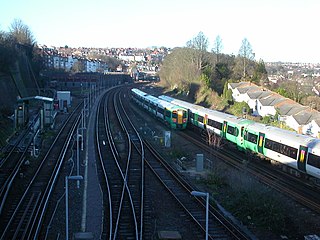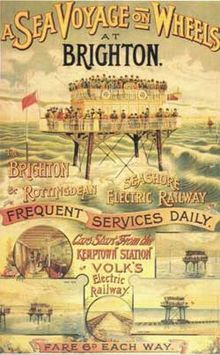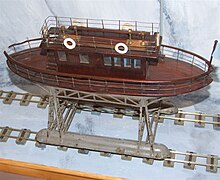
Rail transport is a means of transport using wheeled vehicles running in tracks, which usually consist of two parallel steel rails. Rail transport is one of the two primary means of land transport, next to road transport. It is used for about 8% of passenger and freight transport globally, thanks to its energy efficiency and potentially high speed.

East Sussex is a ceremonial county in South East England. It is bordered by Kent to the northeast, West Sussex to the west, Surrey to the northwest, and the English Channel to the south. The largest settlement is the city of Brighton and Hove, and the county town is Lewes.

A railway track or railroad track (NAmE), also known as permanent way (CwthE) or "P Way" BrE and Indian English), is the structure on a railway or railroad consisting of the rails, fasteners, sleepers and ballast, plus the underlying subgrade. It enables trains to move by providing a dependable, low-friction surface on which their wheels can roll. Early tracks were constructed with wooden or cast-iron rails, and wooden or stone sleepers. Since the 1870s, rails have almost universally been made from steel.

A third rail, also known as a live rail, electric rail or conductor rail, is a method of providing electric power to a railway locomotive or train, through a semi-continuous rigid conductor placed alongside or between the rails of a railway track. It is used typically in a mass transit or rapid transit system, which has alignments in its own corridors, fully or almost fully segregated from the outside environment. Third-rail systems are usually supplied from direct current electricity.
In railway engineering, "gauge" is the transverse distance between the inner surfaces of the heads of two rails, which for the vast majority of railway lines is the number of rails in place. However, it is sometimes necessary for track to carry railway vehicles with wheels matched to two different gauges. Such track is described as dual gauge – achieved either by addition of a third rail, if it will fit, or by two additional rails. Dual-gauge tracks are more expensive to configure with signals and sidings, and to maintain, than two separate single-gauge tracks. It is therefore usual to build dual-gauge or other multi-gauge tracks only when necessitated by lack of space or when tracks of two different gauges meet in marshalling yards or passenger stations. Dual-gauge tracks are by far the most common configuration, but triple-gauge tracks have been built in some situations.

Volk's Electric Railway (VER) is a narrow gauge heritage railway that runs along a length of the seafront of the English seaside resort of Brighton. It was built by Magnus Volk, the first section being completed in August 1883, and is the oldest operational electric railway in the world, though it was not the first electric railway to be built. It was preceded by electrification of Miller's line in 1875, Werner von Siemens' 1879 demonstration line in Berlin and by the Gross-Lichterfelde Tramway of 1881, although none of these remain in operation.

The Pennsylvania-Reading Seashore Lines was a railroad that operated in South Jersey in the 20th century. It was created in 1933 as a joint consolidation venture between two competing railroads in the region: the Pennsylvania Railroad and the Reading Company.

Clevedon Pier is a seaside pier in the town of Clevedon, Somerset, England on the east shore of the Severn Estuary. It was described by Sir John Betjeman, as "the most beautiful pier in England" and was designated a Grade I listed building in 2001.

A sea tractor is a motor vehicle designed to travel through shallow seawater, carrying passengers on a platform elevated above a submerged chassis. The sea tractor was most popular during the early 1930s, as a unique way to give scenic tours to patrons of waterfront hotels and resorts. In other applications, sea tractors were used simply as a ferry through shallow waters. The use of sea tractors has declined since, as boats, ferries, and other aquatic vessels often serve the same function much more efficiently and comfortably.

Magnus Volk FII (1851–1937) was a British-German inventor and pioneering electrical engineer.

The Royal Suspension Chain Pier was the first major pier built in Brighton, England. Opened on 25 November 1823, it was destroyed during a storm on 4 December 1896.

Public transport in Brighton and Hove, a city on the south coast of England, dates back to 1840. Brighton and Hove has a major railway station, an extensive bus service, many taxis, coach services, and it has previously had trolley buses, ferries, trams, auto rickshaws and hydrofoils.

St Wulfran's Church, dedicated to the 7th-century French archbishop Wulfram of Sens, is an Anglican church in Ovingdean, a rural village now within the English city of Brighton and Hove. Parts of the structure date from the early 12th century, and the church is listed at Grade I, a designation used for buildings "of outstanding architectural or historic interest".
Daddy longlegs or daddy long legs may refer to:

The Southend Pier Railway is a 3 ft narrow gauge railway in the English city of Southend-on-Sea, Essex. It runs for 1.25 miles (2.0 km) along the 1.34-mile (2.16 km) length of Southend Pier, providing public passenger transport from the shore to the pier head.

George Herbert "Bert" Volk was a British automobile and general engineer noted as a pioneer builder of seaplanes. He is also the second son of Magnus Volk, who built Volk's Electric Railway, and Anna Volk.

A rail adhesion car or rail adhesion train is a modified vehicle used on a rail adhesion system where the standard equipment does not have locomotives' rail sanding ability. In particular, it may involve tanks and dispensing equipment installed in an electric subway or rail car that is run over the rails alone or in a train to dispense sand when needed. Because of space limits under the cars, the sand or gel/sand mix tanks are installed inside the passenger space.

The Brighton trolleybus system formerly served the town of Brighton, East Sussex, England. Opened on 1 May 1939, it gradually replaced the Brighton Corporation Tramways network.



















